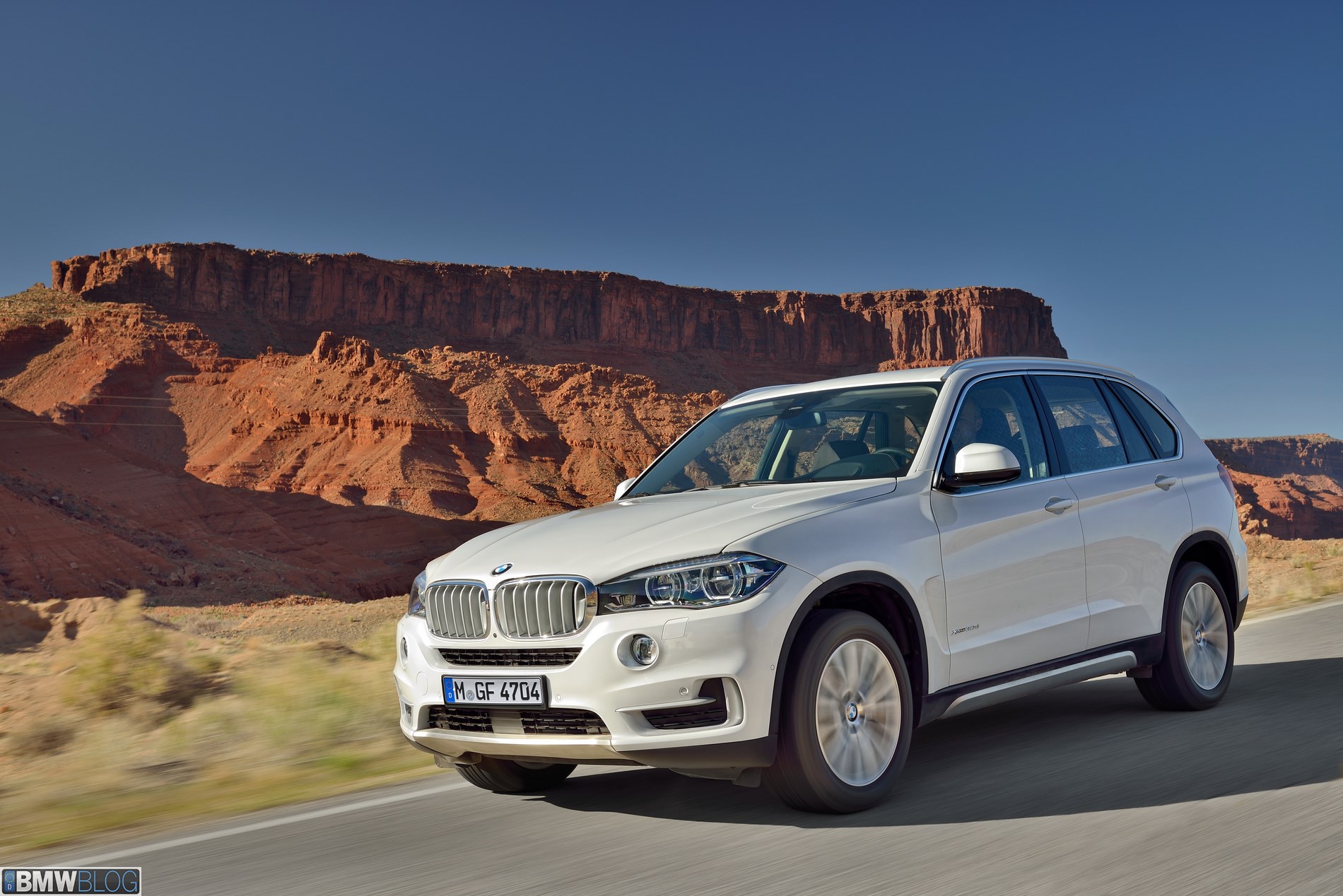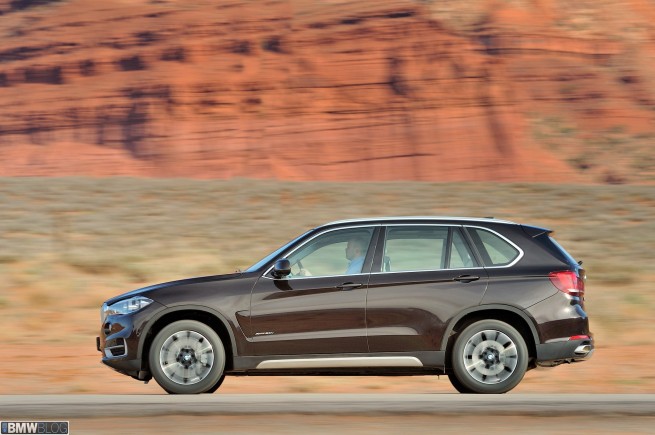Just breaking cover today is the all-new third generation 2014 BMW X5. Evolutionary not revolutionary may just well be the best way to describe this ground up rework of BMW’s venerable X5. To date, BMW has sold over 1.3 million X5s and in the process, BMW pioneered an entirely new segment of vehicles blossoming into a whole line of X, Sports Activity Vehicles. Clearly BMW is onto something and they don’t want to mess it up, so BMW isn’t straying too far from a working formula.
Visually, the new F15 BMW X5, has a more squared off shape with broad shoulders and up-right body compared to the rounded flowing look of the second generation X5. The kidney grilles are much broader and no longer is there any painted surface of the X5 between the headlights and grill. It’s a solid flowing line of glass and grille. The biggest change in the front may be that the kidney grilles don’t lift up when opening the engine compartment as did the first two generation X5s. Be it a manufacturing change to save cost or a design change, it is sure a marked departure of what BMW used to do for thirteen years.
The all new X5 still has short overhangs with a stretched wheelbase and just like the second generation X5 can remarkably accommodate available third row seating. With this option, the X5 can carry up to seven passengers. The pictures reveal the rear overhang to be somewhat longer now and BMW does claim that the interior has more “luxurious spaciousness.” Assuming I am converting millimeters correctly, I measure 1.5 inches more width for passengers in the front seat and an an astounding 4.5 inches more headroom. The press materials list the dimensions in millimeters and U.S. market dimensions are typically listed in inches so we’ll see if this was a typo or not when we get our hands on one at late this year. BMW has added a 40:20:40 split rear seat for the first time in the X5.
Overall, the new X5 is 1.25 inches longer, 1/2 inches shorter, and about 1/4 inches wider. Yet, despite the very similar size gives a much different appearance than the second generation X5. One of my BMWBLOG colleagues even remarked how much it looks like a bigger X3. So what about the most important number of all, the weight? Can a BMW go on a diet? I am happy to report that yes indeed the X5 did loose weight but not much. Just 90 kg per comparable X5 model BMW says, which converts to just under a 200 lbs weight loss. This means that the V8 5.0 is still going to be around 5,100 lbs. Sigh.
BMW doesn’t disappoint in the performance figures though. For the new X5 xDrive50i, 0-100km (0-62mph) now happens in half a second sooner, just 5.0 seconds, with a new generation of the V8 engine which now puts out 450 hp, a whopping 50 hp more to move less weight! Torque figures are up to at 479 lb-ft, a 29 lb-ft gain. Transmission is an über efficient eight-speed gearbox.
BMW is launching two diesels in addition to the V8 Petrol engine, a 30d that makes 258hp, 413 lb-ft avail at a low 1500 rpm and the insane M50d variant BMWBlog has tested in other vehicles with 381hp and 546 lb-ft of torque, such as the X6 M50d. and the M550d xDrive.
For the first time ever, BMW utilizes an aero blade on the new X5. BMW describes it as “black air-channeling elements are contiguous with the roof spoiler and help it to optimize the car’s aerodynamic properties.” It shows up best in their press photos on the white X5. BMW employees several other aero tactics – air curtains and air breathers to help the drag coefficient drop from 0.36 to 0.31.
BMW has not only focused on the looks but fuel economy as well. BMW employes Brake Energy Regeneration, Auto Start-Stop as well as On-demand accessories – meaning not always drawing power from the alternator. Electric power steering, low resistance rolling tires are a few more of the many fuel saving features, which in addition to the 90kg weight loss, more efficient engine and aerodynamics yield a 27 mpg imp which is a 4.4 mpg improvement over the second generation. Please note U.S. figures not in the press materials, just UK imperial, so when we know U.S. figures we’ll put them up.
BMW again leads the class with a litany of electronic and tech updates to the new X5 to keep them at the top of a very competitive market segment. Right of the bat, one’s eyes are drawn to the huge 10.25 inches LCD display sitting atop the dasbhoard. The menus on this are accessed with the new iDrive Touch Controller. Optional is what promises to be an insane Bang and Olufsen high-end sound system 1,200 watts. Did someone say tailgate party? The interior looks classic BMW and again isn’t braking new ground but has added nice enhancements such as an button activated tailgate, larger storage compartments. Off note is that the center stack of controls just up front the gear shift seems to be widened out horizontally almost in an intriguing twin dash treatment.
An insane amount of electronic drivers aids of DSC, ABS, DTC, CBC, DBC, ADB – X. Brake Assist, the Brake Standby feature, Start-Off Assistant, Fade Compensation, the Brake Drying function, trailer stability control and Hill Descent Control (HDC) are standard. A new one called Dynamic Performance Control is optional and essentially functions like torque vectoring. BMW ParkingAssistant, BMW Head-Up display, BMW Night Vision, Dynamic Light Spot Adaptive Headlights….surely I must have missed a few, but you get the picture, this X5 is seriously tech laden.
A non-all-wheel-drive version for the first time, named sDrive, as has the rear-wheel drive X1. BMW will initially launch the new X5 with three variants – xDrive30d, X5 m50d and xDrive50i. BMWBLOG can’t wait to see the X5 M variant.
The all-new third generation BMW X5 does appear to be a conservative revival of the X5. Considering its target market and competition like the Mercedes GL450 and Porsche Cayenne, I can see why it’s not a dramatic departure from last generation.
The X5 looks bigger but at least externally isn’t, and its design is inline with successful sellers for BMW.
We look forward to a thorough test drive review of the X5.
Engine variants:
BMW X5 xDrive50i: V8 petrol engine with BMW TwinPower Turbo technology (two turbochargers, direct injection, VALVETRONIC),
Capacity: 4,395 cc, output: 330 kW/450 hp at 5,500 rpm,
max. torque: 650 Nm (479 lb-ft) at 2,000 – 4,500 rpm.
Acceleration [0 – 100 km/h (62 mph)]: 5.0 seconds,
top speed: 250 km/h (155 mph).
Average fuel consumption according to EU standard:
10.4 – 10.5 litres/100 kilometres (27.2 – 26.9 mpg imp),
CO2 emissions according to EU standard: 242 – 244 g/km (figures depend on the tyre format specified), exhaust standard: EU6.
BMW X5 xDrive30d: Six-cylinder in-line diesel engine with
BMW TwinPower Turbo technology (turbocharger with variable inlet geometry, common rail direct injection),
Capacity: 2,993 cc, output: 190 kW/258 hp at 4,000 rpm, max. torque: 560 Nm (413 lb-ft) at 1,500 – 3,000 rpm.
Acceleration [0 – 100 km/h (62 mph)]: 6.9 seconds,
top speed: 230 km/h (143 mph).
Average fuel consumption according to EU standard: 6.2 litres/100 kilometres (45.6 mpg imp),
CO2 emissions according to EU standard: 162 – 164 g/km (figures depend on the tyre format specified), exhaust standard: EU6.
BMW X5 M50d: Six-cylinder in-line diesel engine with M Performance TwinPower Turbo technology (three turbochargers, high-pressure, with variable turbine geometry), common rail direct injection with piezo injectors, maximum injection pressure 2,200 bar).
Capacity: 2,993 cc, output: 280 kW/381 hp at 4,000 – 4,400 rpm,
max. torque: 740 Nm (546 lb-ft) at 2,000 – 3,000 rpm.
Acceleration [0 – 100 km/h (62 mph)]: 5.3 seconds,
top speed: 250 km/h (155 mph).
Average fuel consumption according to EU standard: 6.7 litres/100 kilometres (42.2 mpg imp),
CO2 emissions according to EU standard: 177 g/km, exhaust standard: EU6.









































































